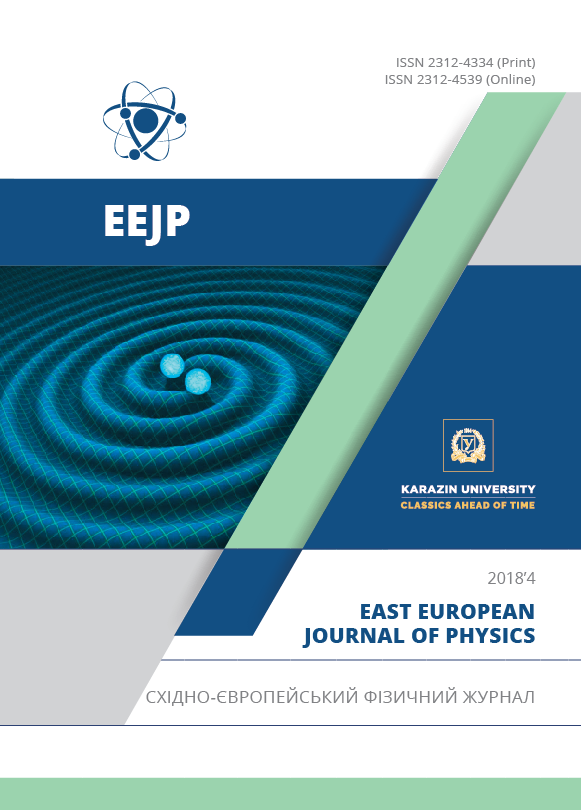Nonlinear Dynamical Analysis on the Formation of Cadmium Oxide by Laser Deposition
Abstract
It is well-known that II-VI compounds occupy a very relevant place in the whole context of semiconductors. In particular, II-VI semiconductor and isolating or quasi-isolating oxides play an important role. Among these materials, we can mention zinc oxide and cadmium oxide. These oxides, which are transparent (at least in the visible range), are suitable for a number of optoelectronics applications. In this respect, let us consider solar cells; indeed, the above oxides serve as antireflection coatings for these cells. Cadmium oxide, doped or undoped, despite it is hazardous to manipulate, is certainly very interesting for the aforementioned optoelectronics applications. On the other hand, many aspects of this oxide may be regarded from the experimental and theoretical standpoints. In relation to the experimental side, several techniques are currently used to produce cadmium oxide. Among these experimental methods, one can mention metal evaporation, sputtering over a glass substrate, and laser deposition. Perhaps, laser deposition is more advanced and promising than the other techniques. In addition, the fact that laser is involved in this type of deposition gives rise to that the main aspects of the physics and chemistry of cadmium oxide are, say, enhanced. Really, the physics and chemistry of cadmium oxide constitute a significant issue. In order to examine accurately the principal physical mechanisms underlying the formation of cadmium oxide by laser deposition, an in-depth theoretical nonlinear study upon the above formation is presented in this article. As a matter of fact, taking into account that the molecules (,,) in the chemical reaction which gives CdO are diatomic, the Morse potential is assumed to act upon the inter-nuclear axis of the molecules which, consequently, behave as quantum anharmonic (nonlinear) oscillators. In fact, associated with the corresponding chemical reaction, inelastic collision between a cadmium molecule and an oxygen one is considered to give rise to two molecules of cadmium oxide. We analyze carefully this collision from the quantum-mechanical point of view (we recall that the molecules in question behave as quantum anharmonic oscillators). From this molecular collision, energy loss is produced due to the laser action. The energy loss is calculated and, from this result, we deduce a mathematical condition to be obeyed for the size of anharmonicity by using a suitable parameter.
Downloads
References
S.Y. Bhide and S. Yashonath, J. Phys. Chem. A. 106, 7130-7137 (2002), DOI: 10.1021/jp020101e
M. Yan, M. Lane, C.R. Kannewurf and R.P.H. Chang, Appl. Phys. Lett. 78, 2342 (2001), DOI: 10.1063/1.1365410
R.A. Ismail, B.G. Rasheed, E.T. Salm and M. Al-Hadethy, J. Mater. Sci.: Mater. in Electronics. 18 (2007) 1027, DOI 10.1007/s10854-007-9129-4
C. Sravani, K.T.R. Reddy and P.J. Reddy, Mater. Lett. 15, 356-358 (1993).
A.A. Dakhel, Curr. Appl. Phys. 11, 11-15 (2011), DOI: 10.1016/j.cap.2010.06.003
D.J. Seo, J. Korean Phys. Soc. 45, 1575-1579 (2004).
F.C. Eze, Mater. Chem. Phys. 89, 205-209 (2005).
T.K. Subramanyan, G. Venkata Rao, K.T.R. Reddy and S. Uthanna, Indian J. Eng. Mater. Sci. 10, 151-154 (2003).
V.E. Rodionov, I.N. Shnidko, A. Zolotovsky and S.P. Kruchinin, Mater. Sсi. 31, 232-239 (2013).
M. Sugahara and S.P. Kruchinin, Mod. Phys. Lett. B. 15, 473-477 (2001).
A.V. Soldatov, N.N. Bogolyubov (Jr.) and S.P. Kruchinin, Condens. Matter Phys. 9, 1-9 (2006).
Authors who publish with this journal agree to the following terms:
- Authors retain copyright and grant the journal right of first publication with the work simultaneously licensed under a Creative Commons Attribution License that allows others to share the work with an acknowledgment of the work's authorship and initial publication in this journal.
- Authors are able to enter into separate, additional contractual arrangements for the non-exclusive distribution of the journal's published version of the work (e.g., post it to an institutional repository or publish it in a book), with an acknowledgment of its initial publication in this journal.
- Authors are permitted and encouraged to post their work online (e.g., in institutional repositories or on their website) prior to and during the submission process, as it can lead to productive exchanges, as well as earlier and greater citation of published work (See The Effect of Open Access).








